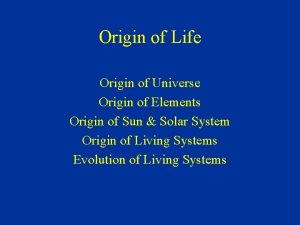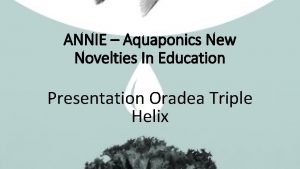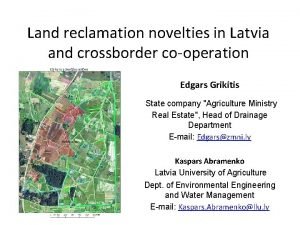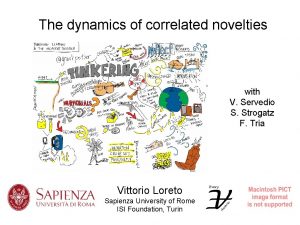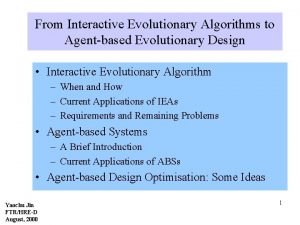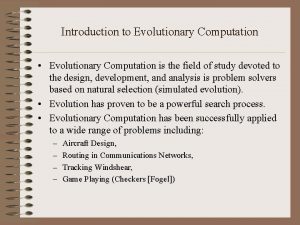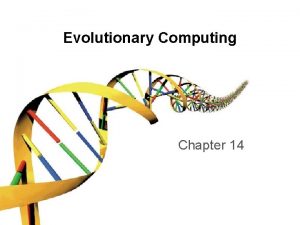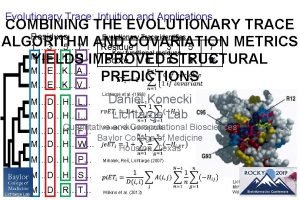ORIGIN OF EVOLUTIONARY NOVELTIES What are the origins








































- Slides: 40

ORIGIN OF EVOLUTIONARY NOVELTIES § What are the origins of novel phenotypes? § Can small quantitative changes lead to large qualitative phenotypic alterations?

CHANGES IN RELATIVE GROWTH RATES CAN RESULT IN COMPLEX TRANSFORMATIONS OF THE PHENOTYPE FROM: D’Arcy Thompson (1942)

EX E PA NS IO N E RA TE TRANSLATION (T) § SIMPLE SHAPE GENERATING CURVES CAN YIELD A DIVERSE ARRAY OF SHELL MORPHOLOGIES (W ST C AN ) DI O FR M TH AX IS (D )

INCORPORTING A DEVELOPMENTAL PERSPECTIVE Small changes in the patterns of growth and development can lead to dramatic evolutionary modifications of the phenotype. Two ways to describe developmental relationships: § ALLOMETRY: The relative rate of growth of traits in an organism during development. § HETEROCHRONY: An evolutionary change in the timing or rate of developmental events.

ALLOMETRIC GROWTH IN HUMANS THERE ARE PRONOUNCED DIFFERIENCES IN THE GROWTH RATE AMONG BODY PARTS

ALLOMETRY POSITIVE ALLOMETRY a>1 § A non-linear growth relationship between them can be expressed: y = bxa § Where a is the allometric coefficient. ln (y) § Consider two correlated traits: x & y ISOMETRIC GROWTH a=1 NEGATIVE ALLOMETRY a<1 ln (x)

POSITIVE ALLOMETRY: y GROWS RAPIDLY RELATIVE TO x ln (y) POSITIVE ALLOMETRY a>1 ln (x) § Legs grow rapidly relative to the torso.

ln (y) NEGATIVE ALLOMETRY: y GROWS SLOWLY RELATIVE TO x NEGATIVE ALLOMETRY a<1 ln (x) § Head grows slowly relative to the torso.

ALLOMETRIC GROWTH AND THE DEVELOPMENT OF CASTES IN THE ANT Pheidole instabilis WORKER CASTE SOLDIER CASTE BASED ON HUXLEY 1932

§ The allometric coefficient often exhibits intraspecific variation. In addition, this variation can have a heritable genetic basis. § Thus, allometry can be the fuel for adaptive evolution by natural selection.

§ ALLOMETRIC GROWTH IN UNGULATES Irish Elk (Megaloceros) Dik-dik HORN LENGTH AND BODY SIZE IN AFRICAN ANTELOPE SPECIES

§ Allometric Scaling between limbs and within hindlimb elements illustrates the complex evolution of proportion

log y EVOLUTIONARY CHANGES IN DEVELOPMENT: PATTERN 1: PERAMORPHOSIS HYPERMORPHOSIS log x ANCESTRAL GROWTH TRAJECTORY: POSITIVE ALLOMETRY log y log x ACCELERATION log x AFTER FUTUYMA 1986

PATTERN 1: PERAMORPHOSIS § HYPERMORPHOSIS: EXTENSION OF ANCESTRAL GROWTH PERIOD LEADS TO AN EXAGGERATION OF ADULT CHARACTERS. § ACCERERATION: INCREASE IN THE RATE OF DEVELOPMENT LEADS TO AN EXAGERATION OF ADULT CHARACTERS.

HYPERMORPHOSIS IN FOSSIL TITANOTHERES

BRAIN – BODY SIZE RELATIONSHIP IN PRIMATES JUVENILE GROWTH TRAJECTORY

log y EVOLUTIONARY CHANGES IN DEVELOPMENT: PATTERN 2: PAEDOMORPHOSIS PROGENESIS log x ANCESTRAL GROWTH TRAJECTORY: POSITIVE ALLOMETRY log y log x NEOTENY log x AFTER FUTUYMA 1986

PATTERN 2: PAEDOMORPHOSIS § PROGENESIS: TRUNCATION OF ANCESTRAL GROWTH PERIOD THE LEADS TO THE RETENTION OF JUVENILE CHARACTERS. § NEOTENY: DECREASE IN THE RATE OF DEVELOPMENT LEADS TO THE RETENTION OF JUVENILE CHARACTERS.

AMPHIBIAN METAMORPHOSIS: A MODEL FOR HETEROCHRONY TYPICAL LARVAL TIGER SALAMANDER (Ambystoma tigrinum) STEBBIN S NORMAL METAMORPHIC ADULT TIGER SALAMAMDER (Ambystoma tigrinum)

ACCELERATION OF DEVELOPMENT § Many amphibian species have lost the free-living larval stage by accelerating development in the egg stage and hatching as fully formed juvenile adults.

A NUMBER OF SPECIES OF AMBYSTOMATID SALAMANDERS HAVE LOST THE METAMORPHIC ADULT STAGE A. mexicanum A. dumerilii These NEOTENIC adult salamanders retain juvenile morphology while becoming sexually mature adults. There is a disassociation between developmental systems.

GENETIC BASIS OF METAMORPHIC FAILURE § This is a common, and independently repeated, theme across a wide diversity of salamander families

HUMANS AS THE RESULT OF NEOTENIC DEVELOPMENT? JUVENILE CHIMPANZEE ADULT CHIMPANZEE

CHIMPANZEE ONTOGENY HUMAN ONTOGENY

CANALIZATION AND GENETIC ASSIMILATION Not all mutations produce mutant phenotypes. Rather, development appears to be buffered so that slight perturbations of the genotype or slight perturbations of the environment do not lead to abnormal phenotypes. This phenomenon is called CANALIZATION (Waddington 1942). NON-CANALIZED TRAIT Phenotype

ILLUSTRATION OF CANALIZATION USING A DEVELOPMENTAL MAP ZONE OF CANALIZATION § LIABILITY = GENOTYPIC VALUE + ENVIRONMENTAL EFFECTS

DEVELOPMENTAL MAP OF BRISTLE NUMBER IN DROSOPHILA ZONE OF CANALIZATION

GENETIC ASSIMILATION § Waddington noticed that environmental stress (such as heat shock) could “break” the canalization and result in the production of novel phenotypes. § These novel phenotypes could then be selected on to produce a population that expressed the new type without the environmental stimulus. NORMAL CROSSVEIN § He called this phenomenon genetic assimilation. CROSSVEINLESS TYPE (HEAT SHOCKED)

WING VEINATION IN DROSOPHILA CAN BE MODELED AS A THRESHOLD TRAIT Normal Phenotype Novel Phenotype THRESHOLD Liability § Under typical environmental conditions all of the individuals have the normal wing phenotype

§ Heat shock moves the threshold so that now some individuals exhibit the novel wing phenotype. POPULATION MEAN § Selection on the novel type advances the population mean so that now some individuals exhibit the novel phenotype even without heat shock.

Evolution of a Polyphenism by Genetic Accommodation Yuichiro Suzuki and H. Frederik Nijhout Fig. 2. Effect of selection on temperature-mediated larval color change. (A) Changes in the mean coloration of heat-shocked larvae in response to selection for increased (green) and decreased (black) color response to heat-shock treatments, and no selection (blue). (B) The reaction norm of generation 13 lines reared at constant temperatures between 20°C and 33°C, and heat-shocked at 42°C. The curves are sigmoidal regressions on the mean data points. Error bars represent 1 SE. Science 3 FEB 2006 311: 650 -652


HEAT-SHOCK PROTEIN Hsp 90 AS A CAPACITOR OF MORPHOLOGICAL EVOLUTION FROM: Rutherford & Lundquist. 1998. Nature 396: 336 -342

HERITABLE DEFECTS IN MORPHOLOGY IN RESPONSE TO STRESS § Selection for deformed-eye trait. § Selection for wing-vein trait. FROM: Rutherford & Lundquist. 1998. Nature 396: 336 -342

Hsp 90 PROVIDES A MECHANISM FOR PROMOTING EVOLUTIONARY CHANGE IN CHANALIZED DEVELOPMENTAL SYSTEMS § The normal function of Hsp 90 is to stabilize signal transduction proteins that are important components of numerous developmental pathways. § Heat shock causes other proteins in the cell to become unstable and Hsp 90 is recruited away from its normal function to the more generalized function of stabilizing these partially denatured proteins. § As a result less Hsp 90 is available to maintain normal developmental pathways. § Hsp 90 m may also play a role in suppressing transposon activity and reducing incoming mutations.

THE EVOLUTIONARY LOSS OR REDUCTION OF COMPLEX STRUCTURES IS A COMMON PATTERN. § EXAMPLE: CAVEDWELLING ORGANISMS

REDUCTION IN DIGIT NUMBER DERIVED PATTERN ANCESTRAL PENTADACTYL PATTERN

EVOLUTIONARY REDUCTION IN DIGIT # (Colchicine treatment) EXPERIMENTAL REDUCTION IN DIGIT #

Hampé’s Experimental Reconstitution of an Ancestral Phenotype

ORIGIN OF MAJOR EVOLUTIONARY NOVELTIES § Almost all macro-evolutionary change can be attributed to the gradual modification of existing structures, e. g. , changes in allometric growth patterns, and heterochronic changes in the relative timing of developmental events. § Small changes in regulatory/developmental pathways can be magnified into major changes in the phenotype. § Canalized traits can be reservoirs of “hidden” genetic variation which can lead to the sudden appearance of novel phenotypes.
 Insidan region jh
Insidan region jh Từ ngữ thể hiện lòng nhân hậu
Từ ngữ thể hiện lòng nhân hậu Trời xanh đây là của chúng ta thể thơ
Trời xanh đây là của chúng ta thể thơ Tư thế ngồi viết
Tư thế ngồi viết V cc cc
V cc cc Voi kéo gỗ như thế nào
Voi kéo gỗ như thế nào Thể thơ truyền thống
Thể thơ truyền thống Sự nuôi và dạy con của hươu
Sự nuôi và dạy con của hươu Thế nào là hệ số cao nhất
Thế nào là hệ số cao nhất Diễn thế sinh thái là
Diễn thế sinh thái là đại từ thay thế
đại từ thay thế Lp html
Lp html Vẽ hình chiếu vuông góc của vật thể sau
Vẽ hình chiếu vuông góc của vật thể sau Thế nào là mạng điện lắp đặt kiểu nổi
Thế nào là mạng điện lắp đặt kiểu nổi Mật thư anh em như thể tay chân
Mật thư anh em như thể tay chân Lời thề hippocrates
Lời thề hippocrates Vẽ hình chiếu đứng bằng cạnh của vật thể
Vẽ hình chiếu đứng bằng cạnh của vật thể Tư thế worm breton là gì
Tư thế worm breton là gì Quá trình desamine hóa có thể tạo ra
Quá trình desamine hóa có thể tạo ra Khi nào hổ mẹ dạy hổ con săn mồi
Khi nào hổ mẹ dạy hổ con săn mồi Các châu lục và đại dương trên thế giới
Các châu lục và đại dương trên thế giới Dot
Dot điện thế nghỉ
điện thế nghỉ Bổ thể
Bổ thể Thế nào là sự mỏi cơ
Thế nào là sự mỏi cơ Phản ứng thế ankan
Phản ứng thế ankan 101012 bằng
101012 bằng Thiếu nhi thế giới liên hoan
Thiếu nhi thế giới liên hoan Fecboak
Fecboak Bài hát chúa yêu trần thế alleluia
Bài hát chúa yêu trần thế alleluia Một số thể thơ truyền thống
Một số thể thơ truyền thống Hệ hô hấp
Hệ hô hấp Cong thức tính động năng
Cong thức tính động năng Bảng số nguyên tố
Bảng số nguyên tố đặc điểm cơ thể của người tối cổ
đặc điểm cơ thể của người tối cổ Tỉ lệ cơ thể trẻ em
Tỉ lệ cơ thể trẻ em Các châu lục và đại dương trên thế giới
Các châu lục và đại dương trên thế giới ưu thế lai là gì
ưu thế lai là gì Tư thế ngồi viết
Tư thế ngồi viết Thẻ vin
Thẻ vin Các môn thể thao bắt đầu bằng tiếng chạy
Các môn thể thao bắt đầu bằng tiếng chạy










































